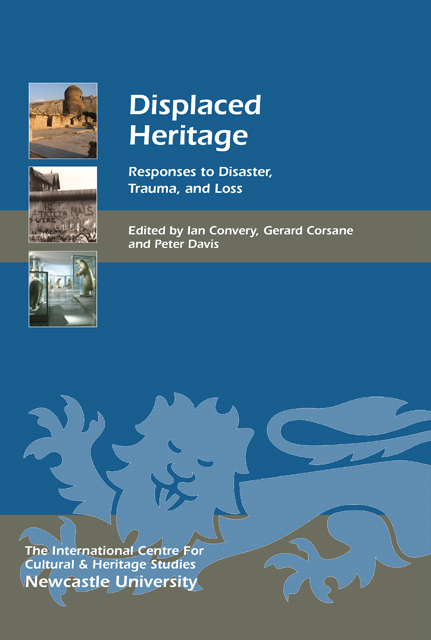Book contents
- Frontmatter
- Contents
- List of Illustrations
- Acknowledgments
- List of Abbreviations
- Preface
- Introduction
- Displaced Heritage: Histories and Tourism
- Displaced Heritage: Trauma, Confinement and Loss
- Displaced Heritage: Lived Realities, Local Experiences
- Displaced Natural Heritage
- Endpiece
- List of Contributors
- Index
- Heritage Matters
6 - Walls, Displacement and Heritage
Published online by Cambridge University Press: 24 February 2023
- Frontmatter
- Contents
- List of Illustrations
- Acknowledgments
- List of Abbreviations
- Preface
- Introduction
- Displaced Heritage: Histories and Tourism
- Displaced Heritage: Trauma, Confinement and Loss
- Displaced Heritage: Lived Realities, Local Experiences
- Displaced Natural Heritage
- Endpiece
- List of Contributors
- Index
- Heritage Matters
Summary
When the Tullie House Museum and Art Gallery Trust was given the opportunity to create a new gallery to reflect the Roman heritage of the area, they took the opportunity to explore the concept of the frontier. As one of the ‘bookends’ to Hadrian’s Wall and with no visible site to interpret, the Trust was able to concentrate on the concept of frontiers, using both historical and contemporary references. This would enable visitors to explore the standing remains with an understanding of what the monument meant to the people living there at the time, both the army and the locals. Much of this concerns displacement of people from their homes, reasons for invasion, lack of a voice and relates to frontiers today. This chapter will show how the gallery illustrates each of these themes through display of artefacts from the museum’s collections, quotations from Roman authors and the use of modern film and oral testimony.
Many of the inhabitants of the Roman Empire were removed from their homes through enlistment into the imperial army. The majority (some 72%) (Mattingly 2006, 166) of the Roman imperial army in Britain was made up of auxiliary troops, enlisted from the peoples who lived in the conquered territories. This served two purposes: it enabled the Empire to make best use of the characteristics and skills of the many different peoples under Roman control, while also serving to minimise rebellion by shipping these levies to far-off parts of the Empire. Thus while Dacians from modern Bulgaria/Romania were used to garrison Hadrian’s Wall along with people from Belgium, Holland, France and Spain, the inhabitants of Britain were posted to Switzerland and North Africa. All of these people were conscripted for 25 years’ service, at the end of which they were rewarded with full citizenship and allowed to marry. However, many were never able to return to their homeland. In the gallery this is represented by the story of the North African levies made by Emperor Septimius Severus at the beginning of the third century ad.
Severus was a native of Leptis Magna, near Tripoli in modern Libya. He became emperor after a civil war in which he defeated, among others, Clodius Abinus, the governor of Britain, who had used the troops stationed in the province in his army. When Severus became emperor, he uprooted many people from his home province to deploy them in Britain.
- Type
- Chapter
- Information
- Displaced HeritageResponses to Disaster, Trauma, and Loss, pp. 63 - 70Publisher: Boydell & BrewerPrint publication year: 2014



